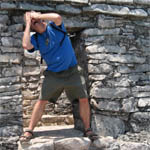With Zen, there is a more direct linkage [to art] than through other mystical forms.
It is the spiritual as direct appreciation of the thing itself. It is like a reverse linkage: you can’t say whether art came from the spiritual or vice versa.
~ Isamu Noguchi*
In my first contact with Buddhist thought, it appeared not tied to ritual, discipline, or lineage, but loosely intertwined with booze, jazz, sex, drugs, radical politics, and the seemingly limitless American road, in the novels and poems of Jack Kerouac and Allen Ginsberg.** A bit later, I had a somewhat more formal introduction, though, still, only through the pages of a book, reading D. T. Suzuki’s Introduction to Zen Buddhism while hitch-hiking through Italy. As such, it was a bit of a revelation to see Ellen Pearlman’s Nothing & Everything: The Influence of Buddhism on the American Avant-Garde, 1942-1962, a book focusing on intersections of Buddhism with not just the Beat Generation, but John Cage, Jackson Pollock, Fluxus, and others, begin with the arrival of none other than D. T. Suzuki to the United States, and ending with his encounters with the likes of Kerouac and Ginsberg.
As Suzuki walked on stage, he was smaller than many people expected. Leaning over, he tapped the microphone. A ping ricocheted out of the loudspeaker. “Zen Buddhism. Very hard understand. Thank you,” he said and walked off.
The book traces the influence on and interaction between (mostly) Zen Buddhist ideas and western music, painting, dance, sculpture, poetry, fiction, and “happenings” from the 40s into the psychedelic era of the 60s. Along the way, it provides a lot of fascinating anecdotes along with explanation of some key Buddhist concepts, as well as usefully elucidating a lot of the thought behind modern art forms, including silent music and seemingly chaotic performance art that continues to baffle the average person even half a century later. As such, this is a book that will be admirably accessible to those who might tend to be frightened away by the apparent strangeness of Zen and/or modern art.
~
Best way to to keep your core pelvic and org@sm muscles strong and resilient? Here’s the coveted apparatus that makes this possible >>
~
“Art itself is tantric, but artists themselves remain very confused.”
~ Sogyal Rinpoche
One interesting facet, which Pearlman highlights, is the way in which the opening of western artists to Buddhism corresponded with an opening of Japanese artists, and Japanese Buddhism, itself, to the west. Most interestingly, as American artists turned to Zen, Japanese artists and intellectuals were, for the most part, distancing themselves from it, seeing it as inextricably tied to fascism and militarism.
What, in the west, appeared to represent a radical opening-up of forms and possibilities, in its home country represented limitation, convention, and conservatism. Ironically, thus, what influence Zen ended up having on the Japanese artists of the time often came by way of Zen-inspired Americans like John Cage.
“An Eastern proverb has it: ‘just one leaf falling and we know autumn is with us.’ Can I not then take the literary movement in San Francisco for a leaf falling from the Paulownia tree, as auguring a possible change in the psychological climate in western culture?”
~ D. T. Suzuki
At the same time, the exact linkages between Zen and the thoughts and works of western artists are thrown into question almost as often as they’re brought up. Were western artists creating true Zen art? Were they misunderstanding Zen? Were they actually influenced by Zen at all, or merely finding Eastern ideas that corresponded, or seemed to correspond, with their own? Following a very amusing story about the first meeting between Kerouac, Ginsberg, and Peter Orlovsky with D. T. Suzuki, we are provided with an illuminating quote from Gary Snyder, perhaps the most serious Buddhist among the major Beats:
Though it’s a charming thought, [Suzuki] has almost no influence on the ‘spontaneity’ element in the writing of Kerouac, Ginsberg, & me. For Jack, it came through his understanding of Jazz musicianship. Ginsberg got it from Jack. I got it from Jack plus R. H. Blyth’s view of Haiku.
As such, at times, the narrative here, seems very much like an extended Zen story, with meaningful points brought up only to be undercut at every turn. This, I think, is fitting, since, if there’s one thing that Zen and the avant-garde share, it’s an inherent and dedicated elusiveness, a fundamental refusal to be defined or pinned-down in any way (or, at least, not in the form of prose explanations). Both are, to some extent, defined by indefinability. As such, to try to firmly establish connections between indefinables is a noble, if, ultimately, quixotic task, that makes a fascinating story.
It is not, however, a particularly well written one. Unfortunately, the book often reads like a rough draft, with clunky prose and often incoherent organization, despite a traditionally academic structure. That, one might say, would certainly puts it more in the tradition of the looseness of the Beats than the discipline of the Zen tradition, but I’m more inclined to see a simple lack of editing, which mars an otherwise very enjoyable and informative reading experience.
* I almost wrote that my first contact with Eastern thought, in general, came through these novels; but, of course, that came through the Beatles and Grateful Dead.
** All quotations in this review are from: Ellen Pearlman, Nothing & Everything: The Influence of Buddhism on the American Avant-Garde, 1942-1962.

 Share on bsky
Share on bsky






Read 3 comments and reply